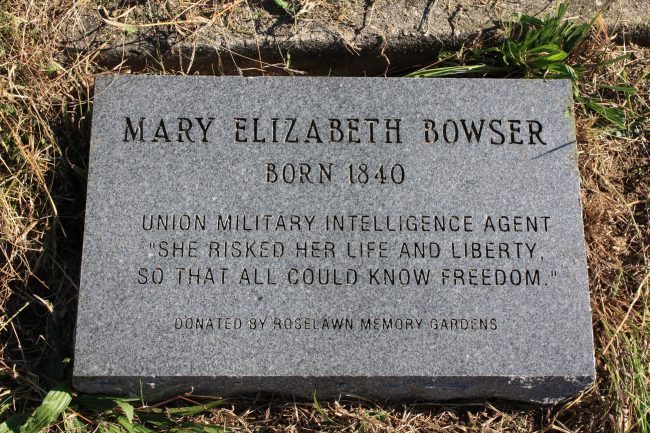In 1839, (an approximate date), Mary Elizabeth Van Lew was born a slave in Richmond, Virginia. Her owner was the John Van Lew family. He was a wealthy hardware merchant.
After his death in 1843 or 1851, (sources differ), Van Lew’s daughter Elizabeth and her mother freed his slaves. When the women learned of slaves of other owners were offered for sale, they purchased and freed them.
Mary remained with the Van Lew family after she had her freedom and worked as a paid servant. Elizabeth sent Mary to the Quaker School for Negroes in Philadelphia in the late 1850’s.
Following her graduation, Mary returned to Richmond and married William or Wilson Bowser, a free black man on April 16, 1861, just a few days before the beginning of the Civil War. Their wedding was unusual because the church where the ceremony was held was mostly white. They settled just outside Richmond, and Mary continued to work for the Van Lew family.
After the war began, Elizabeth Van Lew asked Mary to help her with an elaborate spying system she carried out in the Confederate Capital. Elizabeth was a strict abolitionist, and a Union Army supporter. Because her father was a wealthy and prominent member of Richmond, she was tolerated. Her views and actions, namely attending to the wounds and feeding Union soldiers at Libby Prison, gained her enmity within the community. She used it to her advantage. She managed to appear as a muttering, slovenly, and crazy woman, earning her the nickname “Crazy Bet”. She acquired information from the captives, and when one would escape, she would hide them in a secret room in the family mansion. She wrote ciphered messages and hid them in the soles of servant’s shoes or eggshells, and, with the aid of other agents, smuggled them out to the Union Army.
Mary was exceptionally intelligent, and displayed some acting skills. Hoping to gain access to secret information, she became “Ellen Bond”, a dim-witted, crazy, but very able servant. Elizabeth had a friend take Mary along to help with functions held by Varina Davis, wife of Confederate President Jefferson Davis. She proved herself very efficient, and was taken on full-time in the Confederate White House, where she stayed until just before the end of the war. Of course, they believed she was still a slave.
Racial disrespect assumed that all slaves were illiterate, and lacked intelligence. And slaves were trained to be “invisible”. Mary listened carefully to troop and military strategies exchanged between Davis and his Officers. Serving and cleaning up after meetings gave her access to documents left behind. In Davis’ study, she memorized dozens of vital documents with the aid of a “photographic memory”. She never missed a single word.
Mary collected some of the most vital information about the war and passed it on to Elizabeth on some evenings, meeting her at the Van Lew farm just outside Richmond, or gave it to Thomas McNiven, a reputable Richmond baker. With his business, he was able to pass on information both at the bakery and on his deliveries. When he arrived at the Davis residence, Mary would greet him briefly at his wagon, keeping their conversation as short as possible. Just before his death in 1904, he told his daughter Jeanette about the activities. She passed the information on to her nephew Robert Waitt, Jr., who recorded them in 1952. Thomas said about Mary:
“…as she was working right in the Davis home and had a photographic mind. Everything she saw on the Rebel president’s desk, she could repeat word for word. Unlike most colored, she could read and write. She made a point of always coming out to my wagon when I made deliveries at the Davis’ home to drop information.”
Towards the end of the war, suspicion fell on Mary. It is not known how or why. She fled in 1865, but before she did, she make one last attempt to aid the Union. She unsuccessfully attempted to burn down the Confederate Capitol.
After the war, the government destroyed all records of the southern spy effort, including those of Mary, Elizabeth, and Thomas, that’s why there are no details to tell. It is believed that Mary kept a diary of her actions, and that it was accidentally discarded in 1952. Others say it was intentionally destroyed by her family, fearing retribution by the Confederacy. And still others claim it is in the possession of a Black family who will not disclose its whereabouts.
There is no record of Mary after her escape from Richmond, or when or where she died. It is commonly believed she headed north, possibly to Philadelphia.
In 1995, the U.S. government honored Mary Elizabeth Bowser for her efforts by inducting her in the U.S. Army Military Intelligence Corps Hall of Fame in Fort Huachuca, Arizona. During the ceremony, her contribution was described thus:
“Ms. Bowser certainly succeeded in a highly dangerous mission to the great benefit of the Union effort. She was one of the highest placed and most productive espionage agents of the Civil War. … [Her information] greatly enhanced the Union’s conduct of the war. … Jefferson Davis never discovered the leak in his household staff, although he knew the Union somehow kept discovering Confederate plans.”

No comments:
Post a Comment